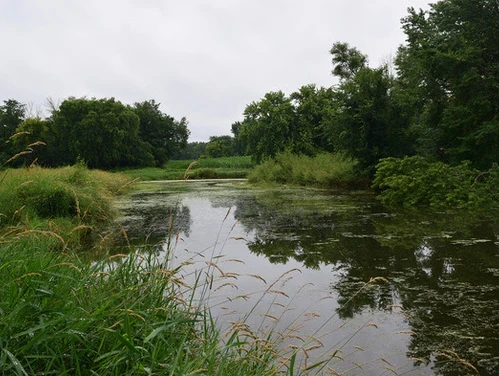The prairie at Red Fox Wildlife Area was still wet from a shower that passed through earlier, but now it was just humid, cloudy and still – unusual for an early July morning.
Often over shadowed by the much larger Dudgeon Lake Wildlife Area a mile or so to the south, Red Fox has a mix of prairie, timber and wetlands, packing a lot of diversity into its 198-acres.
Standing in the parking lot on the south end of the area, a barn owl box sits at the top of a pole in plain view of the prairie. Red Fox is on the northern edge of the barn owl’s native range and while none have yet moved in, local wildlife experts don’t expect that vacancy to last.
“Barn owls haven’t shown up yet, but at some point, we do expect them to,” said Dave Kutz, wildlife technician with the Iowa Department of Natural Resources Iowa River Wildlife Unit, in Swisher.
One way to roll out the welcome mat is to offer quality prairie habitat, and staff are using different management techniques to meet that goal.
Running a disk through the prairie in strips disturbs the grassland and encourages prairie flowers (and insects), which is important for grassland birds and other wildlife. The strips are disked in the fall and rotated around the prairie. Results are easy to see.
“We rotate the strips to always have that dynamic, early successional habitat,” Kutz said.
Beyond the prairie to the north are the wetlands and oxbows ringed by willows.
“We fight a lot of brush around the wetlands and in encroaching into the grasslands. It’s been three years since the last time we removed the willows so it doesn’t take long for them to return. We’ll grind them then farm it for two years before planting it back to prairie,” he said.
The spring and summer rains raised the water levels of the oxbows hidden from the road by the trees and six-foot-tall ragweed, about a half mile north of the parking lot. Rains had also bolstered the local mosquito population to that which would rival those found in the boundary waters of northern Minnesota.
There are a few small food plots – primarily corn – between the wetlands and oxbow. A neighboring farmer partners with the DNR to install some of the habitat and food plots through a lease.
North and west of the wetlands, the area transitions to trees where the Cedar River splits - the main channel flows on the western side; the branch flows diagonally from northeast to southwest, where it rejoins the main channel.
With sandy soils, timber, wetland and prairie, Red Fox supports a diverse wildlife community, including less common species, like Blandings, wood and ornate box turtles, six lined racerunners, bull snakes, as well as plain pocketbook mussels in the river and kitten tail in the prairie.
Located five miles north of Vinton and eight miles west of Urbana, Red Fox Wildlife Area offers those willing to go out of their way an opportunity to enjoy a quality outdoor experience.
“It’s primarily used by local hunters, but it has something for everyone - pheasant hunting, turkey, deer, wetland species and bird watchers,” Kutz said.
